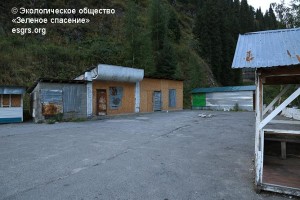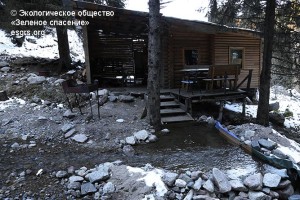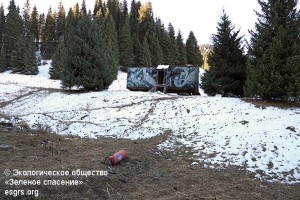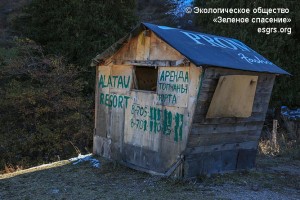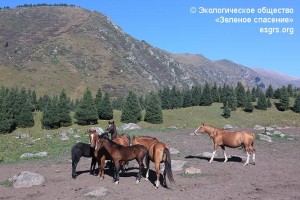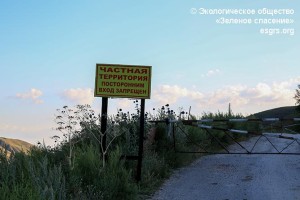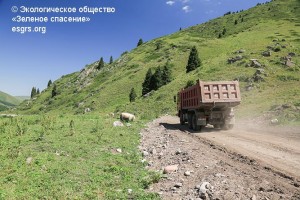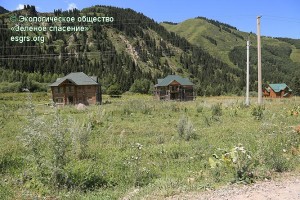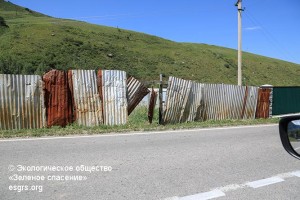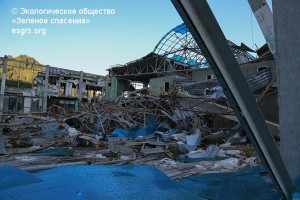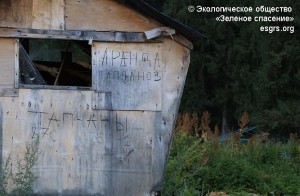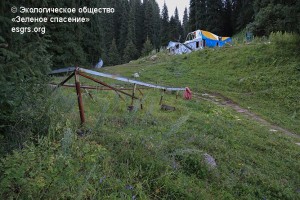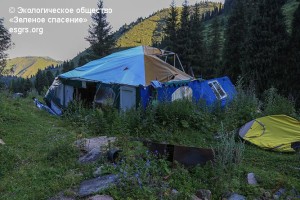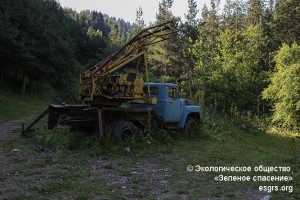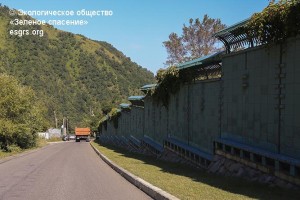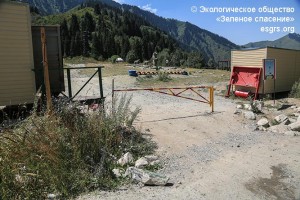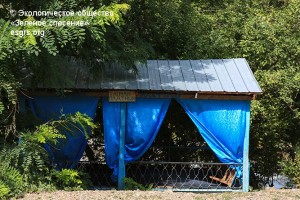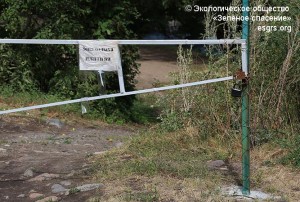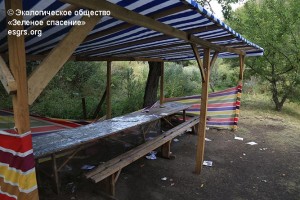We often have to answer journalists’ questions about the reasons for deterioration of the ecological situation in the city of Almaty and its vicinities. There are many reasons. But one of them needs to be highlighted separately.
The city is adjacent to the mountain range — Zailiysky Alatau. This mountain range forms the climate in the region, providing Almaty residents with different vital resources. Significant area of the ridge covered with coniferous and mixed forests was protected by establishing specially protected natural areas — Almaty State Nature Reserve, Ile-Alatau State National Natural Park (SNNP), and Medeu Regional Park. Their purpose is to preserve the natural systems of the mountains, without the normal functioning of which the city and other settlements will cease to exist.
In the last 30-40 years, as a result of chaotic economic human activity, the nature of Zailiysky Alatau has been severely damaged. Misunderstanding of simple truths, desire to get instant profit at any cost, corruption, lack of professional knowledge — these are the main driving forces of the “development” of the mountains. Thus, national parks were viewed as inexhaustible sources of profit. This approach contradicts one of the main principles of sustainable use of nature, which is based on accounting and rational consumption of natural resources, which does not destroy or deplete ecological systems.
A striking confirmation of the desire to squeeze “all juices” out of the nature of the national parks was introduction of numerous amendments into the law “On Specially Protected Natural Territories” of 2006. In particular, limited economic activities were permitted, including construction and leasing (1) of land for up to 49 years.
These “innovations” unleashed hands of tenants who seek maximum profit in the shortest time possible. It is not for nothing that major specialists in the field of forestry wrote in the beginning of the 20th century: “Giving forests for lease is the worst and most expensive way of forest management… Giving forests to a person who is not directly interested in saving them can not be furnished with conditions, which… would guarantee preservation of the forest” (2). The same can be said about leasing lands of national parks.
Recommendations of the IV World Congress of Protected Areas state that “creation and maintenance of protected areas and use of resources on them and around them should be socially responsible and fair” (3).
The economic activities of tenants in national parks do not fit into this definition. Rather, it resembles “a mass destruction of plants or animals, poisoning of the atmosphere, land or water resources, as well as commission of other actions that have caused or are likely to cause an ecological disaster or an environmental emergency”. This is exactly how the Article 169 of the Criminal Code defines ecocide.
Tenants cause enormous damage to the ecological systems of national parks, which threatens their very existence as specially protected natural areas.
1. Damage from construction.
There is a special group of tenants who, under the pretext of developing tourism, build palaces in national parks. While even with a great strain, it is still possible to classify some constructions as touristic sites, but mansions over three- or four-meter fences are more like fortresses (Butakovka Canyon of the Ile-Alatau SNNP). During construction, natural ecological systems, to put it mildly, are erased from the face of the earth. Even the Red Book plants or animals are not taken into account. The resulting construction waste is dumped into neighboring canyons, often on the territory of the national park (Malaya Almatinka and Almarasan Canyon of the Ile-Alatau SNNP).
2. Damage from infrastructure development.
Distribution of lease plots inevitably leads to development of transport and engineering infrastructure that requires additional territories outside the leased land. Development and operation of these facilities lead to irretrievable destruction of previously existing ecosystems.
3. Damage from abandoned sites.
As practice shows, many tenants go bankrupt, and structures that they built come to desolation, get destroyed, turn into unauthorized dumpsters. Only on the territory of the Ile-Alatau National Park, there are several dozens of such “masterpieces” built after the park was founded (Butakovka Canyon, Turgen Canyon of the Ile-Alatau SNNP).
Paragraph 5 of the Article 46-1 of the Law “On Specially Protected Natural Territories” states: “Regardless of a transfer of the long-term land use right granted for implementation of tourist and recreational activities, individuals and legal entities retain the obligation to bring the site to a state that ensures safety of objects of the state natural reserve fund, and compliance with the environmental protection requirements”. But administration of the national parks does not require tenants to strictly observe the laws.
4. Damage from fragmentation of ecosystems.
The allocation of land for leasing is conducted without taking into account natural and recreated ecosystems. As a result, fragmentation of forest tracts, animal habitats and plant growth occurs, and access to water is blocked. Even if in accordance with the paragraph 6 of the Article 46-1 of the above-mentioned law, by the end of a lease period, all facilities are dismantled and removed, even then the natural ecological systems can not be restored. At best, there would be ecosystems that only resemble the original ones.
5. Damage from exceeding ecological capacity.
Land is leased to tenants without taking into account its ecological capacity. Therefore, the land plots often turn into densely packed settlements. This undermines normal functioning of ecosystems and prevents their reproduction. On these lands, there is a rapid degradation of grassy vegetation and soil, trees and shrubs are dying, animals disappear, water sources dry up (Big Almaty Canyon of the Ile-Alatau SNNP).
6. Damage from grazing.
In many cases, cattle graze uncontrollably. As a result, wild animals leave the grazing areas, natural vegetation perishes, soil erosion develops (Kaskelen Canyon of the Ile-Alatau SNNP, Castle Valley of the Charyn SNNP).
7. Damage from pollution and destruction of natural water bodies.
In a number of places, leased plots are located on banks of water bodies. Constructed facilities become sources of chemical and biological contamination. Riverbeds undergo changes. The banks are “ennobled” without taking into account their importance for the life of animals and plants (Big Almaty Canyon of the Ile-Alatau SNNP).
8. Damage from air pollution.
Air pollution has rapidly increased. The main pollutants are vehicles, construction equipment, industrial premises of restaurants, cafes, hotels, heating devices. The amount of dust rising from unpaved and asphalted roads, built by tenants to access their sites, is increasing (Big Almaty Canyon of the Ile-Alatau SNNP, Castle Valley of the Charyn SNNP).
9. Damage from noise pollution.
Noise pollution has become one of the constant factors of violation of the nature protection regulations in national parks. Its sources are construction machinery, cars, various motorized vehicles, for example, motorboats on Lake Issyk, which borders the Almaty Reserve. Restaurants and cafes play loud music (Big Almaty Canyon of the Ile-Alatau SNNP, Castle Valley of the Charyn SNNP).
10. Damage from loss of natural attractiveness.
Tenants modify natural landscapes so severely that the latter lose their former attractiveness. Tourist sites are transformed into food reception points against a background of relatively untouched nature. This is especially apparent on weekends, when hundreds of cars park near restaurants and cafes.
11. Damage from obstacles created for unobstructed movement of tourists.
Numerous fences installed by tenants block tourist paths, roads, sights of national parks. In some places, they completely obstruct access to natural objects.
12. Damage from man-made disasters.
Practically uncontrolled activity of tenants significantly increases the threat of man-made disasters. Tenants cut slopes, destroy vegetation cover, change riverbeds, increase fire hazard, provoke erosion of soils. A striking example is the rain floods, which began to arise as a result of leveling slopes to improve the ski tracks at the Chimbulak resort.
13. Damage from violation of conventions.
The Law “On Specially Protected Natural Territories” does not specify special protection regulations for territories and species of living organisms subject to international conventions. Even on wetlands of international importance, “protected and reserve types of regulation or regulated economic activity” are established (Article 75), as for ordinary specially protected areas.
That is, tenants can also obtain land in national parks, for example, listed on the World Heritage List or its tentative list. This is practiced, for example, in the Ile-Alatau National Park.
In the legislation, there are no norms obliging tenants to comply with the requirements of the conventions. “Business” in national parks greatly reduces the parks’ chances of being included in the World Heritage List.
No one keeps track of the amount of damage from the tenants’ activity. And how can one estimate thousands of hectares of ecological systems destroyed for the sake of gluttony in nature, racing on off-road trucks, and poaching. As the American economist Paul Samuelson wrote: “Woe to the culture that destroys its monuments of glory and fills the countryside with sale stands of fried chicken and hot dogs”.
Our requirements.
As practice shows, the country’s legislation does not allow for effective protection of the most valuable natural complexes. Therefore, we believe that it is necessary to make significant changes to the legislation. In 2016, 2017 and 2018, our organization prepared and submitted comments on the current law “On Specially Protected Natural Territories” to the Parliament (Why Is the Law Bad and Why Doesn’t It Protect National Parks?: http://esgrs.org/wp-content/uploads/2015/01/Why-Is-the-Law-Bad-Green-Salvation-Herald-20171-15.pdf).
We believe that first of all, it is necessary to introduce the following changes into the law.
1. To supplement paragraph 1 of the Article 14 of the law with the words:
“For effective organization of maintenance and protection, specially protected natural areas are classified into the following categories: of international, national and local value.
Protected areas of international value are the territories included in the UNESCO World Heritage List or those covered by other international agreements ratified by the Republic of Kazakhstan. Objects of outstanding universal, cultural and natural value, requiring special protection regulations, are located on these territories.”
2. Introduce the law with an article on a more strict environmental regulation for the territories included in the UNESCO World Heritage List or those covered by other international agreements.
3. Prohibit alteration of functional zoning of existing national parks on the basis of so-called “adjustments of feasibility studies”.
4. Prohibit leasing of land in national parks.
5. Remove outsider landowners and tenants from national parks and reserves.
The material was prepared by
S.G. Kuratov, V.V. Krylov.
Ecological Society “Green Salvation”
(1) The term “lease” is not used in the Forest Code (with amendments and additions as of 01.01.2018) and the Law “On Specially Protected Natural Territories” (with amendments and additions as of June 15, 2017). But in the Land Code (with amendments and additions as of July 11, 2017), Article 35, paragraphs 1 and 2, reads: “1. A land plot can be granted to individuals and legal entities on the right of temporary paid land use (lease) or on the right of temporary free land use. 2. … The right of temporary paid land use (lease) can be short-term (up to 5 years) and long-term (from 5 to 49 years)”. Article 37 of the Land Code is actually called “The right of temporary paid land use (lease)”.
That is, paid land use is lease. Therefore, replacement of the concept of «lease» for «use» in the above mentioned laws does not change the essence of the transaction.
(2) I. Shutov. About forest income of Russia. Forest Journal. 2001, №5-6, p.154: https://cyberleninka.ru/article/v/o-lesnom-dohode-rossii (as of December 08, 2017).
(3) Parks for life: report of the fourth World Congress on National Parks and Protected Areas, 10-21 February 1992 — Gland, IUCN, 1993, p. 35, Recommendation 6: https://portals.iucn.org/library / node / 6584 (as of January 6, 2018).
Subscribe to our updates

